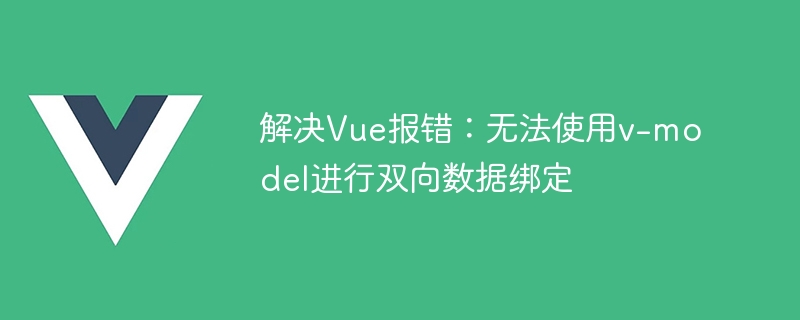解決Vue報錯:無法使用v-model進行雙向資料綁定

解決Vue報錯:無法使用v-model進行雙向資料綁定
在使用Vue進行開發時,經常會使用v-model指令來實現雙向數據綁定,但有時候我們會遇到一個問題,就是在使用v-model時會報錯,無法正確進行雙向資料綁定。這可能是由於一些常見的錯誤導致的,以下我將介紹幾種常見的情況以及相應的解決方法。
- 元件的props屬性未正確設定
當我們在使用元件時,如果需要透過v-model進行資料綁定,那麼元件的props屬性需要正確設定。首先,在元件的props選項中,需要定義一個value屬性,作為v-model的綁定值。然後,在元件內部,需要透過觸發input事件來更新value的值。以下是一個範例程式碼:
// Parent.vue
<template>
<div>
<Child v-model="message" />
</div>
</template>
<script>
import Child from './Child.vue';
export default {
components: {
Child
},
data() {
return {
message: ''
};
}
};
</script>
// Child.vue
<template>
<div>
<input type="text" :value="value" @input="$emit('input', $event.target.value)" />
</div>
</template>
<script>
export default {
props: {
value: {
type: String,
required: true
}
}
};
</script>在上述程式碼中,我們將父元件的資料message透過v-model綁定到了子元件的value屬性上,並在子元件的input事件中透過$emit來觸發input事件,並傳遞新的值。這樣就可以實現雙向資料綁定了。
- 元件未正確觸發input事件
有時候我們在編寫自訂元件時,可能會忘記在適當的地方觸發input事件,這也會導致無法正確使用v-model進行雙向資料綁定。以下是一個範例程式碼:
// CustomInput.vue
<template>
<div>
<input type="text" :value="value" @input="updateValue" />
</div>
</template>
<script>
export default {
props: {
value: {
type: String,
required: true
}
},
methods: {
updateValue(event) {
this.$emit('input', event.target.value);
}
}
};
</script>當我們使用這個自訂元件時,記得正確觸發input事件,否則v-model將無法進行雙向資料綁定。
- 元件未正確使用v-bind.sync修飾符
Vue提供了v-bind.sync修飾符,用於簡化使用v-model進行雙向資料綁定的運算。當我們在父元件中使用子元件時,可以透過v-bind.sync來實現雙向資料綁定。以下是一個範例程式碼:
// Parent.vue
<template>
<div>
<Child :message.sync="message" />
</div>
</template>
<script>
import Child from './Child.vue';
export default {
components: {
Child
},
data() {
return {
message: ''
};
}
};
</script>
// Child.vue
<template>
<div>
<input type="text" :value="value" @input="$emit('update:value', $event.target.value)" />
</div>
</template>
<script>
export default {
props: {
value: {
type: String,
required: true
}
}
};
</script>在上述程式碼中,我們在父元件中使用子元件時,透過v-bind.sync將父元件的message屬性與子元件的value屬性進行雙向資料綁定,然後在子元件中透過$emit('update:value', $event.target.value)來觸發update:value事件,並傳遞新的值。這樣就可以實現雙向資料綁定了。
總結
透過以上的介紹,我們可以總結一些解決Vue無法使用v-model進行雙向資料綁定的方法。首先,確保元件的props屬性被正確設置,並在元件內部正確觸發input事件;其次,可以使用v-bind.sync來簡化雙向資料綁定的操作。希望本文介紹的方法對解決Vue無法使用v-model進行雙向資料綁定問題有所幫助。
以上是解決Vue報錯:無法使用v-model進行雙向資料綁定的詳細內容。更多資訊請關注PHP中文網其他相關文章!

熱AI工具

Undresser.AI Undress
人工智慧驅動的應用程序,用於創建逼真的裸體照片

AI Clothes Remover
用於從照片中去除衣服的線上人工智慧工具。

Undress AI Tool
免費脫衣圖片

Clothoff.io
AI脫衣器

Video Face Swap
使用我們完全免費的人工智慧換臉工具,輕鬆在任何影片中換臉!

熱門文章

熱工具

記事本++7.3.1
好用且免費的程式碼編輯器

SublimeText3漢化版
中文版,非常好用

禪工作室 13.0.1
強大的PHP整合開發環境

Dreamweaver CS6
視覺化網頁開發工具

SublimeText3 Mac版
神級程式碼編輯軟體(SublimeText3)
 vue中怎麼用bootstrap
Apr 07, 2025 pm 11:33 PM
vue中怎麼用bootstrap
Apr 07, 2025 pm 11:33 PM
在 Vue.js 中使用 Bootstrap 分為五個步驟:安裝 Bootstrap。在 main.js 中導入 Bootstrap。直接在模板中使用 Bootstrap 組件。可選:自定義樣式。可選:使用插件。
 vue怎麼給按鈕添加函數
Apr 08, 2025 am 08:51 AM
vue怎麼給按鈕添加函數
Apr 08, 2025 am 08:51 AM
可以通過以下步驟為 Vue 按鈕添加函數:將 HTML 模板中的按鈕綁定到一個方法。在 Vue 實例中定義該方法並編寫函數邏輯。
 vue中的watch怎麼用
Apr 07, 2025 pm 11:36 PM
vue中的watch怎麼用
Apr 07, 2025 pm 11:36 PM
Vue.js 中的 watch 選項允許開發者監聽特定數據的變化。當數據發生變化時,watch 會觸發一個回調函數,用於執行更新視圖或其他任務。其配置選項包括 immediate,用於指定是否立即執行回調,以及 deep,用於指定是否遞歸監聽對像或數組的更改。
 vue多頁面開發是啥意思
Apr 07, 2025 pm 11:57 PM
vue多頁面開發是啥意思
Apr 07, 2025 pm 11:57 PM
Vue 多頁面開發是一種使用 Vue.js 框架構建應用程序的方法,其中應用程序被劃分為獨立的頁面:代碼維護性:將應用程序拆分為多個頁面可以使代碼更易於管理和維護。模塊化:每個頁面都可以作為獨立的模塊,便於重用和替換。路由簡單:頁面之間的導航可以通過簡單的路由配置來管理。 SEO 優化:每個頁面都有自己的 URL,這有助於搜索引擎優化。
 vue返回上一頁的方法
Apr 07, 2025 pm 11:30 PM
vue返回上一頁的方法
Apr 07, 2025 pm 11:30 PM
Vue.js 返回上一頁有四種方法:$router.go(-1)$router.back()使用 <router-link to="/"> 組件window.history.back(),方法選擇取決於場景。
 vue.js怎麼引用js文件
Apr 07, 2025 pm 11:27 PM
vue.js怎麼引用js文件
Apr 07, 2025 pm 11:27 PM
在 Vue.js 中引用 JS 文件的方法有三種:直接使用 <script> 標籤指定路徑;利用 mounted() 生命週期鉤子動態導入;通過 Vuex 狀態管理庫進行導入。
 vue遍歷怎麼用
Apr 07, 2025 pm 11:48 PM
vue遍歷怎麼用
Apr 07, 2025 pm 11:48 PM
Vue.js 遍歷數組和對像有三種常見方法:v-for 指令用於遍歷每個元素並渲染模板;v-bind 指令可與 v-for 一起使用,為每個元素動態設置屬性值;.map 方法可將數組元素轉換為新數組。
 vue的div怎麼跳轉
Apr 08, 2025 am 09:18 AM
vue的div怎麼跳轉
Apr 08, 2025 am 09:18 AM
Vue 中 div 元素跳轉的方法有兩種:使用 Vue Router,添加 router-link 組件。添加 @click 事件監聽器,調用 this.$router.push() 方法跳轉。






